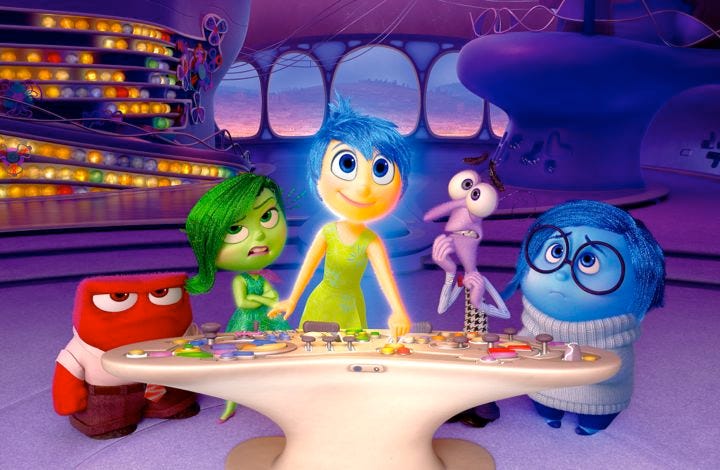[This is part of BFNow Self-Study Module 1: Self-Awareness and Self-Compassion. For more about the overall Self-Study program, please look at About BFNow Self-Study and BFNow Self-Study Orientation.]
If you haven’t done so already, let me encourage you to pause, relax and release, perhaps with three deep breaths.
Today’s exploration involves discovering – and listing – your sub-personalities.
Many psychological approaches recognize that each of us has a variety of recurring behavior patterns that are often called sub-personalities. These sub-personalities show up in the various roles we play and in the ways we behave differently in different situations. You can think of sub-personalities as bundles of traits that show up in particular contexts.
Have you seen the movie Inside Out? This animation envisions subpersonalities based on five emotional states: Anger, Disgust, Joy, Fear and Sadness:
It’s really well done but that’s only one approach to our inner complexity.
I’m not aware of any well-recognized precise definition of what a sub-personality is. Fortunately we won’t need to be precise. In our terms, if personality is the territory, then sub-personalities are a way to map the various patterns of beliefs, feelings, thoughts, behaviors and perceptions that function as a personality in a particular context. Like all maps, our lists will be partial, selective and provisional.
I want to emphasize that having sub-personalities is totally normal and not to be confused with dissociative identity disorder (which used to be known as multiple personality disorder).
An example may help. Below is a mind map of some of my sub-personalities. (Modeling the privacy you will have, I’ve not included my more troublesome ones.) I encourage you to look at that mind map.
I won’t go through all of the sub-personalities on the map; I’ll just mention a few:
Tigger (from Winnie The Pooh) comes out when I’m feeling all enthused and bouncy
Research Hunter likes to research almost anything, hunting new information
Murphy’s Watchman is vigilant and wary for what might go wrong
Inner Critic is a classic part of what Freud called the super ego and can be harsh and judgmental.
I’ve also included a list of Ages, some in my past and others in my future, since I act like these ages at various times.
Experiential
With that as background, for today’s experiential, make a list (or a mind map) of your sub-personalities. You can do it on paper or electronically – just know that the list is likely to grow over time.
The list will be for your eyes only. You won’t be expected to share it with anyone else so be as blunt with yourself as you like.
Don’t worry about precision and it’s OK to be a little playful. Use names that are meaningful for you even if no one else would understand. The goal is to create a list that, taken as a whole, feels true to the many facets you experience in yourself.
Come up with at least 10 (not counting ages). List as many as you like although you are likely to hit diminishing returns beyond 30 sub-personalities.
Include some that you like, some you may feel shy to acknowledge and some you are uncomfortable with or at least aren’t proud of. If you can’t think of any in one or another of these categories, don’t force it. Just be as diverse as is true for you on this day.
At the end of your list (or in a separate part of your mind map), make a list of personality types (sub-personalities) you see in other people that you find particularly annoying or disturbing plus those you find particularly admirable. This could be something you see in only one other person or in many, but in any case use a name for the personality type that is descriptive rather than the proper name of a person.
Observe yourself throughout your day as you are in different settings and interacting with different people. Who (of your sub-personalities) shows up at work, at home and out in the world? Who shows up when you are with friends, with family, with colleagues?
Ask one or more people who know you well to suggest additional ones. You don’t have to include their suggestions but others can help you get past your blindspots, both positive and negative.
Read over your list at the end of the day, perhaps adding to it. Read them aloud if that feels comfortable. Name them and claim them.
If you have questions or comments, please post them here.
Thanks!
Robert
[Link back to the Module 1: Self-Awareness and Self-Compassion Overview page.]
PS – Additional Resources for Subpersonalities
I like this part of the Wikipedia article on subpersonalities:
“Many schools of psychotherapy see subpersonalities as relatively enduring psychological structures or entities that influence how a person feels, perceives, behaves, and sees him- or herself. Over the history of psychotherapy, many forms of therapy have worked with inner diversity representations or subpersonalities.[4][5] Early methods were Jungian analysis, Psychosynthesis, Transactional analysis, and Gestalt therapy. These were followed by some forms of hypnotherapy and the inner child work of John Bradshaw and others. Eventually, forms of therapy largely based on working with subpersonalities have arisen – Voice Dialogue, Ego-state therapy, and John Rowan’s work in Transpersonal psychology.[6] The most recent and widespread subpersonality method is Internal Family Systems Therapy, developed by Richard C. Schwartz. He sees DID alters as on the same continuum as IFS parts (subpersonalities), the only difference being that alters are more polarized and split off from the rest of the internal system.”
If you want to really go deep, I recommend checking out Voice Dialogue as a great experiential/therapeutic approach or John Rowan’s book for a conceptual survey.



